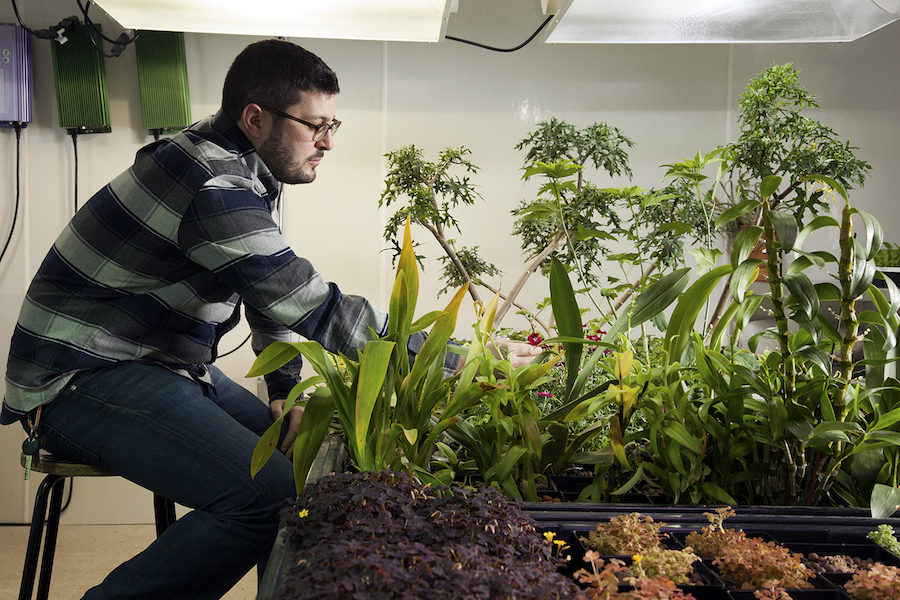Atera has a botanical fetish. This much is clear from the moment you enter the TriBeCa restaurant’s 18-seat dining room. There is the tabletop hewn from a single, massive slab of tree trunk; the “living wall,” a vertical forest floor crawling with ivy and trailing succulents; orchids and aloe that spring from window boxes and flower pots.
The woodland onslaught begins before you even set foot in the door: Hanging outside the restaurant’s entrance is Atera’s logo, etched into a hunk of tree stump.
Many of the 20-plus courses that comprise Atera’s tasting menu would not look out of place in a Japanese rock garden, or perhaps a terrarium: crispy fried lichen moss, razor clams fashioned into trompe l’oeil twigs, sorbet disguised as a moss-covered stone. If ever a restaurant channeled the wild world, Atera is it.
“We really wanted to have a farm, and that’s still a hope of ours, but we knew we needed to do something to get our hands dirty in the meantime,” says staff horticulturalist Ian Rothman.
Matthew Lightner, Atera’s recently departed chef (who, by the time you’re reading this, has passed the baton to chef Ronny Emborg), came to New York from Portland, Oregon, a city abnormally pervaded by nature — forget urban parks, Portland has an urban forest system. Life in Gotham, however, affords no such spatial luxuries: We build 50 stories high, fashion parks from abandoned railway tracks, stack our bookshelves two rows deep. With no prospect of finding arable land nearby, Lightner took a basement storage closet and transformed it into a subterranean garden.
“We really wanted to have a farm, and that’s still a hope of ours, but we knew we needed to do something to get our hands dirty in the meantime,” says Ian Rothman, who has served as Atera’s staff horticulturalist since before the restaurant opened in the spring of 2012. “So we decided to do something with the space we had. That’s how we arrived at hydroponic growing.”
One Monday afternoon, Rothman led me from Atera’s dining room down an elevator, through a doggy daycare business, around a warren of subterranean hallways to a locked door. Inside was a room no larger than a prison cell, flooded with halogen light and filled with tables sporting flats of various edibles, their roots bathed in water.
The system here is simple: 600-watt bulbs stand in for sunlight while reservoirs of nutrient-fortified fluid pump up to water tables, feeding the plants from the bottom up. The operation is focused solely on garnishes to finish Atera’s often-intricate plates. These might include flowers like nasturtiums, Queen Anne’s lace and hibiscus; an assortment of fleshy, plump succulents; herbs such as buckler leaf sorrel and woodruff; and greens, including Malabar spinach, lamb’s-quarters and red Russian kale. All told, Rothman cultivates around 50 plant varieties at any given time.
Two levels below Worth Street, Rothman and Lightner created a farm without seasons, a sort of locavore cheat allowing Atera to source warm-climate plants in the dead of winter without even leaving the building. (Rothman’s crop list does vary by time of year, for aesthetic reasons if not agricultural ones; in the cold months, he tends to focus more on white flowers and hearty greens.)
Besides year-round productivity, another obvious benefit to the hydroponic arrangement is freshness: Fragile ingredients are in the kitchen minutes after they are harvested, preserving their delicate, ephemeral flavors and textures.
But what really excites Rothman about the basement setup — what makes it worth the added effort and expense — is that it allows the kitchen a level of control and creativity when it comes to their ingredients that wouldn’t otherwise be possible. “The big advantage to working this way is it means being able to utilize our vision, not the farmer’s vision,” says Lightner. “I can get exactly the varieties of produce I want, grown exactly to my specifications.”
This equates to plants treated in what Rothman jokingly refers to as “bonsai style,” hand-harvested literally leaf by leaf.
“About a third of the plants in this room you could technically buy at the market at some time or another, but I have so much more control here,” says Rothman. “When I harvest 100 leaves here, 80 of them we can use. When I go to the market and buy a pound of kale, even micro-kale, only 30 percent maybe fits in with our exact specs.”
“The big advantage to working this way is it means being able to utilize our vision, not the farmer’s vision,” says Lightner. “I can get exactly the varieties of produce I want, grown exactly to my specifications.”
The hydroponic environment also has its own impact on how the plants develop. Take collard greens: Grown at high density under artificial light and left to mature for 60 days, they wind up smaller and more intensely flavored than their field-grown counterparts. Rothman considers specimens grown this way to be superior to micro greens — the wispy young seedlings that many chefs use to garnish dishes — which he finds to be comparatively insipid in look and flavor.
Almost three years into the operation, experimentation also plays a major role in Rothman’s approach to growing. He has tinkered with his nutrient solution to observe the physical impact on the plants — a shift in concentrations might produce a streak of red veining, or an interesting curl to a leaf or petal.
One day he sifted through a bucketful of ground ivy, an aromatic creeper provided by the restaurant’s forager, until he found a sprig that was variegated: Instead of pure green, these leaves had white patterning. Rothman admired the unusual appearance and used the sprig to generate a series of new plants, all variegated. This type of customization may seem minor, but it can be significant in a culinary landscape where competition for novelty is intense.
While Lightner may never have gotten that farm, the partnership that he hands over to his successor, chef Ronny Emborg, is in many respects an ideal chef/farmer collaboration. Crop planning has been a joint effort, with Rothman conducting research and experimentation guided by an in-depth understanding of aesthetic and culinary aims, and the kitchen adapting dishes to what the hydropon- ic setup is capable of producing.
At press time, Emborg was eager to cook from every urban chef ’s dream: a living larder. After all, here in New York, he said, “space is a hot commodity.”
Photo credit: Scott Gordon Bleicher



